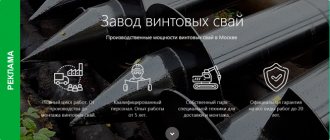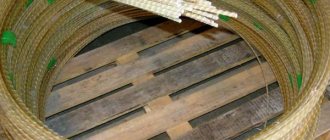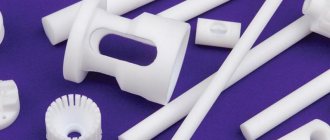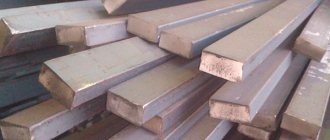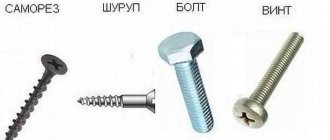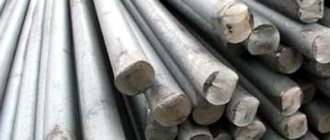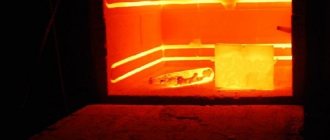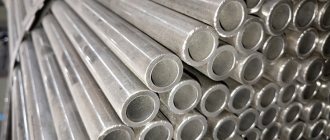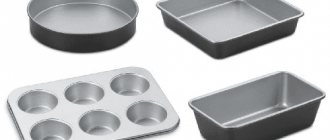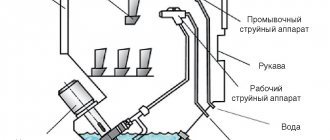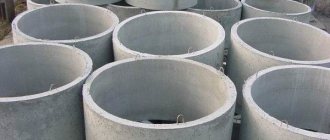The construction industry is one of the fastest growing and changing in the modern world. Before one piece of know-how appears somewhere in the depths of a specialized university, the idea is immediately picked up by business. Fiberglass reinforcement is one of these materials that has literally revolutionized the construction industry. A successful combination of science and engineering has made it possible to create a special material for construction and installation work that surpasses traditional ones in quality and characteristics.
Material that looks more like cake candles does some serious work
Assortment and GOST standards
Non-metallic composite reinforcement was developed back in the USSR in the 60s, but mass production of the material was never established due to the high cost of fiberglass at that time. However, composite reinforcement was used in the construction of several large objects, including power lines in Batumi, Moscow and bridges in Khabarovsk.
To date, there is no GOST standard with technical requirements for this material (the project is under development). The main regulatory act is SNiP No. 52-01-2003 “Composite reinforcement” , according to which fiberglass products can be used in construction as a replacement for rolled metal. Each manufacturer has specifications for its products, along with which test reports and approval certificates are supplied.
Diameters of composite reinforcement
Composite reinforcement is produced in the diameter range of 4-20 mm. The profile of the rods can be corrugated or smooth. Depending on the material of manufacture, the following types of non-metallic products are distinguished:
- ASP - fiberglass reinforcement, made from fiberglass bound with a layer of synthetic resin;
- ABP - basalt-plastic products, in which the fiberglass core is replaced by a melt of basalt fibers;
- ASPET - products made of fiberglass and polymer thermoplastic;
- AUP - carbon fiber reinforcement.
The most common in construction are ASP and ABP; carbon fiber reinforcement is used less frequently due to the lower mechanical strength of the material.
Areas of application
Application of sp. reinforcement in construction is practiced in the construction of residential, public and industrial buildings, as well as low-rise buildings, where ASP is used for:
- reinforcement of reinforced concrete structures (walls and floor slabs);
- repair of surfaces of brick and reinforced concrete objects;
- layer-by-layer masonry of walls using flexible connection technology;
- reinforcement of foundations of all types (slab, strip, columnar);
- reinforcement of floors and screeds;
- strengthening walls and aerated concrete blocks and installing monolithic reinforced belts.
Reinforcement of the foundation with fiberglass reinforcement
The use of sp. is widespread. fittings and in the field of road and railway construction, in which ASP is used:
- when constructing embankments and road surfaces;
- when strengthening road slopes;
- during the construction of bridges;
- when strengthening coastlines.
Composite polymer reinforcement for reinforcing concrete structures is completely resistant to corrosion and chemically aggressive substances, which significantly expands the scope of its application.
Advantages of TSA
Composite reinforcement has the following operational advantages:
- The material is classified according to the first group of chemical resistance; it can be used in acids and alkaline environments.
- Fiberglass (hereinafter referred to as f.p.) reinforcement (FRP) has 3 times greater tensile strength than steel. This allows the use of smaller diameter products in construction.
- The weight of ASP is 4 times less than that of rolled metal - c.p. the reinforcement has a density of 1.9 kg/m
3, metal - 7.9 kg/m
3
.
- Composite reinforcement for foundations costs 50-60% less than rolled metal with similar performance characteristics.
- ASP is easy to transport without the need for trucks - rods with a diameter of up to 10 mm are supplied in coils of arbitrary length, a hundred-meter coil of 8 mm rods weighs about 7.5 kg.
Coil of fiberglass reinforcement in the trunk
- ASP has low thermal conductivity; it does not form cold bridges in masonry made of aerated concrete blocks or inside a reinforced concrete structure.
- S.p. foundation reinforcement is a dielectric; they do not conduct electricity and are not subject to corrosion under the influence of stray currents.
- The service life of the ASP exceeds 80 years.
data-ad-client=»ca-pub-8514915293567855″ data-ad-slot=»1955705077″>
Disadvantages of s.p. reinforcement - low modulus of elasticity (4 times less than that of steel), which limits the possibility of its use in vertical reinforcement, and a tendency to lose strength when heated above 600 degrees. Please note that composite reinforcement cannot be bent under construction site conditions - if it is necessary to use bent elements, you must order them separately from the manufacturer.
This is interesting: Pros and cons of composite fiberglass reinforcement
What is fiberglass reinforcement
Fiberglass reinforcement for foundations is produced on the basis of composite materials and is sold in the form of longitudinal rods with a thickness of 4-18 mm. Their surface is covered with notches or winding.
To manufacture such structures, two components are used:
- Fibers from various inorganic raw materials.
- Polymer additives with a thermoplastic or thermosetting structure.
A strong base for the rods is made from binding elements, which give the final product the required strength properties.
The areas of use of fiberglass products are quite extensive. Construction of foundations for residential and industrial buildings is one of them. With the help of such reinforcement, you can give the foundation additional strength and reliability.
Depending on the materials used in the production process, the following types of composite reinforcement are distinguished:
- Fiberglass.
- Basalt-composite.
- Aramidocomposite.
- Carbon composite.
There are combined options that contain different components. The most popular type is the fiberglass variety, which resembles the structure of wood. Along the length of the rod there are fibers that contribute to the formation of a single base.
Comparison of ASP and metal analogues
We bring to your attention a comparison of the technical characteristics of composite and steel reinforcement.
| Type of fittings | Metal | Fiberglass (FRP) |
| Material of manufacture | Steel grade 25G2S or 35 GS | Fiberglass bonded with synthetic resin |
| Weight | 7.9 kg/m 3 | 1.9 kg/m 3 |
| Resistance to tensile loads (MPa) | 360 | 1200 |
| Modulus of elasticity (MPa) | 200 000 | 55 000 |
| Relative extension (%) | 24 | 2.3 |
| Stress-strain relationship | Curved line with yield plateau | Straight line with elastic-linear dependence until destruction |
| Linear expansion (mm/m) | 14-15 | 9-11 |
| Resistance to corrosive environments | Low, susceptible to rust | High, does not rust |
| Thermal conductivity of materials (W/mK) | 47 | 0.46 |
| Electrical conductivity | Present | Dielectric |
| Diameters | 6-80 mm | 4-20 mm |
| Measured length | 6-12 m | Arbitrary length according to customer's request |
Let's consider a comparison of interchangeable diameters of composite and metal products using the example of A3 brand rods:
- A3 6 mm - ASP 4 mm;
- A3 8 mm - ASP 6 mm;
- A3 10 mm - ASP 8 mm;
- A3 12 mm - ASP 8 mm;
- A3 14 mm - ASP 10 mm;
- A3 16 mm - ASP 12 mm.
Review of fiberglass reinforcement (video)
Beware: unscrupulous manufacturers
The introduction of innovations in the building materials market is always difficult. Composite reinforcement is no exception. On the one hand, many large and small manufacturers have appeared. On the other hand, all factories operate according to their own technical conditions and try to lure buyers with cunning tricks. Let's look at the most common myths.
Myth: Our products are better because we add secret ingredients (which also give an atypical bright color).
Fact: Pigmentation does not affect durability, its only advantage is aesthetics. Moreover, an incorrectly selected pigment can impair performance properties. All technical characteristics must be documented in test reports.
Myth: The more often the winding ribs are located, the stronger the reinforcement.
Fact: Wrapping ribs serve to increase adhesion to the concrete composition and do not in any way affect the tensile strength or compression of the reinforcement. The only exception is a sand coating, which evenly distributes the load along the entire length of the rod.
Myth: Fiberglass reinforcement can be broken by hand, what strength can we talk about?
Fact: Reinforcement made of composite materials works on longitudinal, not transverse loads.
Unfortunately, there are no GOST standards for composite reinforcement yet. Therefore, choose products from trusted manufacturers, ask the seller for certificates and test reports, compare them with the indicators given above and do not be fooled by the temptingly low cost.
13.08.14
Myths about composite reinforcement
Myth No. 1. Composite reinforcement cannot be used due to its low elastic modulus.
In fact, the value of this indicator is important only in structures subject to deflection. And for structural elements located on an elastic foundation, the importance of this factor is reduced to zero, since the foundation itself will not allow the element to bend.
Cost of composite reinforcement
The cost of composite reinforcement consists of the following parameters:
- on the diameter of the building material;
- from the raw materials used in production;
- on the presence/absence of ribs;
- on the delivery format of the product: cut or in a coil;
- on the volume of the purchased batch;
The unit of measurement is the linear meter. Compared to metal products, the cost of which is measured per ton, composite reinforcement for the same weight will be more expensive. But you need to understand that this material is much lighter, so in fact, metal fittings are 3 times more expensive.
Technology for the production of composite products
Fiberglass reinforcement is made from roving (fibers of the original raw material), a binder material - polymer resin, a hardener and a hardening accelerator. The specific ratio of materials depends on the temperature and humidity inside the production room.
The production line includes the following equipment:
- Heating hopper - this is where the fibers are heated to increase adhesion to the resin.
- Impregnation bath - the roving is impregnated with a mixture of resin and hardeners.
- Wrapper - presses raw materials through dies, through which rods of a given diameter are formed.
- Equipment for applying sand, where sand granules are evenly distributed over the surface of the rod, and excess is removed by air flow.
- A polymerization furnace, where the rods gain their design strength.
- Equipment for cooling products is a 3-5 meter long line located at the outlet of the polymerization oven.
- Broaching equipment, cutting mechanism and installation for winding coils - finished fiberglass reinforcement is cut into sections of the required length or wound into commercial coils 50-100 m long.
Composite reinforcement production line
There are many standard solutions for production lines on the market, including all the necessary equipment. The cost of a new line varies between 3-5 million rubles .
Medium productivity equipment is capable of producing up to 15,000 m of reinforcement during a working day.
Reviews about the application
To get a picture of the advisability of using composite products, read the reviews of people with experience in their use.
V. P. Bobyrev, 39 years old, Moscow:
Plastic reinforcement for the foundation is an excellent replacement for rolled metal. I speak as a builder with 10 years of experience. The house itself stands on a composite-reinforced MZF - no problems. The performance characteristics of the composite allow it to withstand any load in low-rise construction, so it can be used with confidence.
S. O. Chernov, 48 years old, Rostov:
Composite reinforcement is a good business. I have my own small production, which has been operating for 4 years - there are always enough clients. Used equipment can be found on the secondary market for reasonable money (up to 1 million); everything pays off in less than half a year. I personally reinforced the walls of a house made of aerated concrete blocks with a composite and was satisfied.
Related articles:
Portal about reinforcement » Types » Advantages and disadvantages of fiberglass reinforcement
This is interesting: Stainless steel pipes for water supply and heating
Features of the structure
Fiberglass reinforcement is not just a rod made of composite material. It consists of two main parts.
- The inner rod consists of parallel fiberglass fibers connected to each other using a polymer resin. Some manufacturers produce reinforcement, the fibers of the inner trunk of which are not parallel to each other, but are curled into a pigtail. It should be noted that it is the inner rod of the fiberglass reinforcement that forms its strength characteristics.
- The outer layer of a reinforcing bar made of fiberglass can be made in the form of bidirectional winding of fibers of a composite material or in the form of spraying of fine abrasive powder.
Fiberglass reinforcing bars with abrasive coating
The design of fiberglass reinforcement bars, which largely determines their technical and strength characteristics, depends on the imagination of the manufacturers and the manufacturing technologies they use for this material.
Comparison with metal fittings
When conducting comparative tests of reinforcement made of steel and composite materials, the following features exist:
- Steel products are afraid of corrosion processes, and composites can withstand any aggressive environment.
- Metal allows cold to pass through, and composite products have a low degree of thermal conductivity.
- The weight of fiberglass reinforcement is several times lower than the weight of steel analogues.
When choosing a material for reinforcement, all factors must be taken into account. With a long list of advantages, innovative fiberglass structures also have disadvantages, and the classic metal version has been used for many decades.
Distinctive features
Independent reinforcement of the foundation with fiberglass reinforcement requires a preliminary study of all the advantages and disadvantages of this material in order to be able to use them with maximum efficiency.
The main points that you need to pay attention to when planning and carrying out work can be identified as follows:
- The product does not require complex, expensive equipment for cutting and laying; the main costs consist of the cost of the material. When comparing fiberglass and steel rods of the same Ø, metal reinforcement is distinguished by a warehouse price, which is 10 - 20% less.
- The use of fiberglass reinforcement is practical in low-rise individual construction, since it is much easier and cheaper to transport, store, and cut. All this can be done with your own hands and on personal transport. For the required length of rod, components are purchased that facilitate installation (plastic ties) and maintaining the distances between the meshes (prefabricated spacers)
- The plastic does not need to be straightened before installation. Material from a whole coil is cut into intervals of any desired length. This significantly reduces waste generation.
- Polymer materials are not subject to corrosion and are not afraid of not only water, but also other aggressive influences. Such reinforcement will be required in concrete mortar with the addition of special modifiers.
- Indicators of thermal resistance and electrical conductivity for fiberglass are considered for specific cases. The influence of thermal conductivity is often exaggerated for advertising purposes, since the main place in this issue is occupied by the thermal insulation of concrete building structures. Based on this, the low thermal conductivity of the polymer will not play a significant role. Dielectric properties provide advantages in cases where the reinforced concrete support does not provide outlets for the ends of the rods for installing a grounding loop or performing lightning protection.
- The disadvantages of fiberglass reinforcement also include the impossibility of independently producing bent sections - this can only be ordered from the manufacturer according to the provided drawings; eliminating the use of welding in problem areas; temperature restrictions (steel can withstand at least 600°C).
- The declared service life of 80 years has not yet been confirmed in practice. Composite compositions belong to organic materials, and how polymer bonds will behave over a long period of time during the aging of this organic material has not yet been established for certain. However, the development and use of composites began more than 50 years ago in harsh climates where steel quickly rusted and lost its properties, and bridge supports still stand today.
A visual demonstration of how to knit a frame made of fiberglass reinforcement for a foundation is shown in this video:
It is extremely necessary to approach the construction of foundations with polymer reinforcement on soils where large bending deformation loads occur, when installing grillages and slabs for heavy buildings. A preliminary calculation should confirm the possibility (with a margin of safety) of using such innovative materials or prohibit them
How is mating carried out?
The key to creating a reliable reinforcing frame is the competent connection of the elements that make it up. The methodology for carrying out the work depends on the specifics of the object and the technical specifications of the construction project. There are several connection methods.
- Clips. The rods are fixed using a special bar with presses. This method is the simplest, fastest and most convenient. The components are fastened at an angle of 90°. The size of the clips must correspond to the diameter of the reinforcement used. This connection ensures strength and rigidity of the structure.
- Plastic clamps. This is the second easiest method of connecting spas. The clamps are tightened at the intersection of the rods. For greater rigidity, two clamps are cross-connected at once. Using pliers, remove the excess part of the fastener. It is not recommended to leave protruding ends as they can create voids. Moisture entering them will negatively affect the strength and durability of the structure.
- Metal wire. In this case, a simple or semi-automatic hook is used. The method is suitable for bars of various diameters.
To connect the SPA, there are special fasteners that are secured with latches. There are special automatic tying guns that fasten rods to staples or wire.
Knitting SPA when reinforcing screeds
The design of concrete floors, thick screeds and slab foundations is carried out using plastic racks. Each of them is an independent reinforcing element. The rods are secured at right angles with crimp latches along the edges of the post. For such a connection, it is not necessary to cut large pieces of reinforcement and knit between horizontal layers.
For thin screeds, it is allowed to use clips for composite reinforcement having a C-shape. With their help, it is easy to obtain the required gap between the base and the reinforcing mesh.
Knitting fiberglass reinforcement for strip foundations
If there are intersections, corners, or lateral junctions, the frame lines are connected using U-shaped parts. They allow you to connect external reinforcement to a perpendicular mesh. The corners are formed by attaching L-shaped rods to the main frame with two wire ties. The resulting overlap must be at least 300 mm. Finished reinforcing mesh is connected by straight sections. All intersections are knitted inside the formwork at the installation site. The distance from its borders must be at least 25 mm.
It is not recommended to heat reinforcing bars to create a bend yourself. This can lead to loss of strength characteristics of the material. To avoid problems, ready-made rods of the required shape are ordered.
Strapping is an important process to obtain a strong frame structure. Compliance with technology serves as a guarantee of quality.
Foundation reinforcement technology
Thanks to the reduced weight of plastic reinforcement and the ability to use rods of any length, assembling a reinforcing frame is much easier than using metal rods. The increased strength of polymer reinforcement for foundation materials allows the use of a smaller cross-section.
For example, steel reinforcement with a diameter of 12 mm, often used for installing foundations in private construction, is replaced with 8 mm plastic, and 10 mm rods with 7 mm polymer.
A calculation table that will help you determine exactly what diameter can be used in each individual case.
The technological process of installation work using plastic reinforcement for the foundation is carried out in several stages, as shown in the video at the end of the article:
- installation of formwork;
- marking the concrete pouring level;
- assembly of the reinforcing frame;
- pouring concrete;
- removal of formwork.
Installation of the formwork structure when reinforcing a strip foundation with fiberglass reinforcement must be carried out in accordance with the design to ensure the exact configuration and dimensions of the foundation elements. When constructing formwork from wooden boards, chipboard or plywood, it is recommended to wrap the panels in glassine. This will save the material and reuse it.
After this, on the inside of the enclosing elements, using a water level, it is necessary to mark the upper level of the future monolith. They will allow you to navigate when pouring concrete and ensure its even distribution.
Assembly of the reinforcing frame
The layout of the reinforcement and the dimensions between individual rods are always indicated in the project. If you use fiberglass reinforcement in the foundation, you can change the diameter of the rods to a smaller one, but the layout should be done only according to the drawing.
Scheme of reinforcement of a monolithic slab.
Initially, it is necessary to unwind rods of the required length from the coil and install them on stands parallel to each other. At specified intervals, place transverse bridges on the longitudinal strings. Tie the reinforcement at the intersections with tying wire or tighten it with tight plastic clamps (more about tying here). As a result, the bottom row of the frame will be ready for reinforcing the foundation with fiberglass reinforcement.
Prepare vertical posts of the required length. The top row of the frame is knitted similarly to the bottom row. After assembly, both rows are placed on top of each other and, starting from the edge, their vertical posts are connected, gradually raising the top row of reinforcement.
After assembling the structure, it must be moved and installed inside the formwork fence, as shown in the photo.
Before installing the reinforcing frame, sand is poured into the bottom of the trench and spilled with water or compacted. It is recommended to cover the compacted sand surface with waterproofing material or geotextile fabric. This will prevent moisture from entering the foundation and increase its reliability and service life.
In the process of installing a foundation made of fiberglass reinforcement, it must be remembered that the edges of the rods should not reach 5 cm from the formwork and the bottom of the trench. To ensure this condition, you can use special plastic fasteners such as “post” and “star” or dense moisture-resistant stone materials.
Belt reinforcement.
Pouring concrete mixture
Laying concrete inside the formwork is done in exactly the same way as when using metal reinforcement. However, extreme caution should be exercised, since the strength of fiberglass reinforcement may be insufficient under strong lateral impacts. Compacting concrete with a vibrator or tamper must be done in such a way as not to damage the installed frame.
Rules for working with material
Work with polymer products must be carried out in compliance with the following rules:
- Handle and move composite rods while wearing gloves. To do this, it is better to use cotton gloves or mittens with a latex coating applied to the back.
- Coils with rods up to 10 mm in diameter are carried manually. And coils with a composite with a diameter of 12 mm or more are rolled around the territory. Do not allow reinforcement strands to fall from a height of more than 500 mm.
- Unwind the coil only in a vertical position. Remove the packaging elements and leave the rings to make it more convenient to cut the reinforcement into pieces of the required length.
- Composite with a diameter of up to 8 mm is cut using an angle machine. Larger rods are cut with a circular saw. The cutter must wear safety glasses and gloves.
- The reinforcement is knitted using steel wire and nylon clamps. See below for how this is done.
Horizontal reinforcement
This method of using composite reinforcement in construction is used for the installation of slab foundations. Their main difference from strip-type bases is the absence of corners and adjacent areas. In fact, the entire structure is made in the form of two large grids, located one above the other. All assembly work is carried out at the installation site, since moving an assembled element of such a large size is quite problematic.
Therefore, the required number of longitudinal rods is initially laid. Transverse ones are placed on them and a mesh is knitted using wire or clamps. The second one is knitted directly on it. After this, the lower mesh must be raised onto stands above the bottom of the pit. Next, the upper mesh can be placed on vertical posts installed at the intersections of the reinforcement.
Basic properties
Fiberglass reinforcement, according to the results of numerous studies conducted by competent organizations, has a number of characteristics that distinguish it favorably from other materials of similar purpose.
- Fiberglass reinforcement bars have a low weight, which is 9 times less than the weight of similar metal products.
- Fiberglass reinforcement, unlike metal products, is very resistant to corrosion and perfectly withstands acidic, alkaline and salty environments. If we compare the corrosion resistance of such reinforcement with similar properties of steel products, it is 10 times higher.
- The property of fiberglass reinforcement to conduct heat is significantly lower than that of metal products, which minimizes the risk of cold bridges occurring during its use.
- Due to the fact that fiberglass reinforcement is much easier to transport, and its service life is much longer than that of metal, its use is more profitable in financial terms.
- Fiberglass reinforcement is a dielectric material that does not conduct electric current and is absolutely transparent to electromagnetic waves.
- Using such material to create reinforcing structures is much simpler than metal rods; there is no need to use welding equipment or technical devices for cutting metal.
Comparative characteristics of steel and fiberglass reinforcement
Thanks to its undeniable advantages, fiberglass reinforcement, having appeared relatively recently on the domestic market, has already gained high popularity among both large construction organizations and private developers. However, such fittings also have a number of disadvantages, the most significant of which include:
- fairly low elastic modulus;
- not too high thermal stability.
The low modulus of elasticity of fiberglass reinforcement is a plus in the manufacture of frames to strengthen the foundation, but a big disadvantage if it is used to reinforce floor slabs. If it is necessary to turn to this particular reinforcement in such cases, it is necessary to first carry out careful calculations.
Schedule for replacing steel reinforcement with composite reinforcement
The low thermal stability of fiberglass reinforcement is a more serious drawback that limits its use. Despite the fact that such reinforcement belongs to the category of self-extinguishing materials and is not capable of serving as a source of fire spread when used in concrete structures, at high temperatures it loses its strength characteristics. For this reason, such reinforcement can only be used to strengthen those structures that are not exposed to high temperatures during operation.
Another significant disadvantage of reinforcement made of fiberglass is that over time it loses its strength characteristics. This process is significantly accelerated if it is exposed to alkaline environments. Meanwhile, this disadvantage can be avoided if you use fiberglass reinforcement made with the addition of rare earth metals.
What it is?
These are non-metallic rods with a smooth and periodic profile. They are made from fibers, both natural and synthetic, which are then impregnated with a viscous polymer.
Classification
Non-metallic rods are divided according to the main source material into three groups:
Fiberglass reinforcement (FRP) consists of fiberglass rods impregnated with thermosetting resins.
The fibers create durable lengths that are tightly bound with a quick-hardening binder;- Basalt plastic products (BPP) are basalt fibers bonded with the same polymer resins as ASP. Composite rods are resistant to aggressive environments.
- Carbon fiber long lengths (CFL) are the strongest, but also the most expensive material and are not used for tying frames of monolithic foundations.
Specifications
The main technical characteristics of composite reinforcement include the following indicators:
- Tensile strength .
Tensile strength is the most important characteristic of reinforcement as it experiences breaking loads in the foundation monolith. The tensile strength of composite rods is several times higher than their steel counterparts. This feature of polymer lengths is noticeable when, according to calculations, a composite ø 8 mm can replace steel rods ø 12 mm. Where rods are subject to deflection, steel products are used. The composite cannot withstand this type of deformation. - Elastic modulus .
The characteristic reflects the ability of a material to restore its shape after deformation from external forces. The higher this indicator, the lower the likelihood of microcracks appearing in the monolith mass. In this parameter, steel is superior to polymer. This applies to structures subject to bending. The modulus of elasticity of steel reinforcement is 200,000 MPa. For the composite it is 55,000 MPa. Therefore, instead of steel rods, almost 4 times more composite reinforcement will be required. - Specific elongation. The parameter reflects the increase in the length of the rod after its rupture and is expressed as a percentage.
To put it simply, the characteristic affects the cracking of the monolith. The higher its value, the greater the risk of destruction of the concrete structure.If the specific elongation for fiberglass and basalt is 2.2 - 2.5%, then for steel it is 25%.
Density _
Characterized by the specific gravity of the material. The greater the weight of one unit of volume of the rod, the stronger it is. The density of the composite is approximately 2 tons/m3, while for steel its value is 7.85 tons/m3.- Thermal conductivity .
The ability of materials to transfer thermal energy to less heated bodies is called thermal conductivity. The reinforcement laid in the foundation with low thermal conductivity will prevent heat from escaping from the house. The thermal conductivity coefficient of the composite is 0.35, for steel it is 46. - Anti-corrosion resistance . In this regard, steel products are completely inferior to composite rods. Polymers are not subject to corrosion, but they lose their strength characteristics due to aging.
- Dielectric properties .
In contrast to the high electrical conductivity of steel reinforcement, composite frames in a monolith do not interfere with transmitting electrical devices. Dielectric polymers do not interfere with the passage of radio signals due to the absence of their own electromagnetic fields. - Weight. The total mass of the foundation depends on how much the material weighs. The use of a composite significantly reduces the pressure of the foundation on the soil base.
Polymer material, unlike steel products, is transferred in small batches into the formwork by hand.Plastic rods are much easier to transport than steel rods. Firstly, it is stored and transported in bays, and secondly, for transportation it is enough to use a small truck such as a Gazelle.
comparison table
In order to understand how much lighter a composite of steel reinforcement is, the table is presented:
| Diameter, mm | Weight of 1 linear meter of reinforcement, grams | |
| Composite | Steel | |
| Ø 6 | 56 | 220 |
| Ø 8 | 94 | 390 |
| Ø 10 | 145 | 615 |
| Ø 12 | 200 | 890 |
| Ø 14 | 280 | 1210 |
| Ø 16 | 460 | 1580 |
| Ø 18 | 560 | 2000 |
| Ø 20 | 630 | 2470 |
| Ø 22 | 730 | 2980 |
| Ø 24 | 850 | 3850 |
What to look for when choosing
When the choice fell on the use of fiberglass reinforcement when performing construction and installation work, then when purchasing it you should pay attention to such indicators as:
- Diameter - must correspond to the declared values.
- The color of the fittings must be uniform and with shades no darker than those in the declared characteristics.
- The quality of winding of the outer layer.
- Products must have appropriate quality certificates and test reports.
Important! The presence of SPA color in darker shades than those declared by the manufacturer indicates that the manufacturing temperature conditions were violated during the production process. Reinforcement of this color is burnt and its technical characteristics cannot correspond to the declared ones.
The flexibility of the SPA allows it to be used in the construction of structures of complex geometric shapes without cutting
When choosing a spa, it is best to initially find out the reputation of the company producing this material, for which you should read reviews on the Internet and in other sources of information.
Expert's point of view
Dmitry Kholodok
Technical director of repair and construction
“When winding the outer layer of reinforcement, pinching of the inner rod of the product should not be allowed, because otherwise, the strength characteristics of the spa will be compromised.”
DIY strip foundation: step-by-step instructions. In the article we will look at the pros and cons of this foundation, the nuances of its correct pouring, as well as which brand of concrete is best to choose in order to get a high-quality structure.
Blind areas around buildings
A blind area is a strip with a width of 0.6 m to 1.2 m, which is adjacent to the foundation or base of a building with a slope.
The slope of the blind area must be at least 1% (1 cm per 1 m) and no more than 10% (10 cm per 1 m).
It is recommended to construct a blind area around the building using fiberglass reinforcement, since the main task of the blind area is to drain surface rain and melt water from the walls and foundation of the house. A blind area using fiberglass reinforcement will last several times longer, since fiberglass reinforcement has high anti-corrosion properties, which prevents the occurrence of cracks in concrete.
Which reinforcement is better: metal or fiberglass?
Perhaps, if we compare these two materials, the usual metal material significantly loses in quality, but wins in price. In this case, you should pay attention to the scope of application. And also study comparative characteristics.
| Characteristic | Metal | Fiberglass |
| Tensile strength, MPa | 390 | 1300 |
| Thermal conductivity coefficient, W/m 2 ×K | 46 | 0,35 |
| Density, kg/m 3 | 7850 | 1900 |
| Elasticity | + | + |
| Plastic | + | — |
| Corrosion resistance | — | + |
| Dielectric properties | — | + |
Leading manufacturers
The production of composite fiberglass reinforcement is carried out in many regions of our country. This especially applies to areas with developed industrial infrastructure, such as:
- Moscow and the Moscow region - "Moscow Composite Materials Plant", LLC "NPC "SPETSPOLIMER", LLC NPK "ARMASTEK" and others;
- St. Petersburg and Leningrad region - “Leader-Composite” and others;
- Yaroslavl - “Yaroslavl Composites Plant”;
- Ekaterinburg and Sverdlovsk region - Uralteplostroy, UZKT LLC, Elpromtekh LLC, NPF UralSpetsArmatura LLC;
- Saratov - LLC "Povolzhskaya Armatura" (Polarm).
For your information! In many cities, spa production is carried out by small enterprises operating at the local level, so if you need to find a similar production in your region, you need to study the building materials market.
A wide range of SPA allows you to choose not only by technical characteristics, but also by the form of implementation
How to avoid problems?
The main problems associated with the use of glass fiber rods are poor quality/defective material and poor engineering design calculations. Problems can arise in the construction of a house if the characteristics of the fiberglass reinforcement used are not taken into account.
Accurate calculations, careful execution of work, and strict adherence to the manufacturer’s recommendations for the selection and installation of materials will help you avoid problems during and after construction.
It is possible to check the quality of a product before purchasing only visually. To do this, you should pay attention to the following points.
- Manufacturer. If the product is not purchased from a factory, you must request documentation for the product confirming its quality and factory (not artisanal) type of production.
- Color. Uniform color throughout the entire bar indicates quality. An unevenly colored product means that the production technology was violated. Brown color indicates the substance is burning out.
- Green indicates insufficient heat treatment.
The use of fiberglass reinforcement in some cases is advisable instead of metal reinforcement. Sometimes it is permissible to combine metal and fiberglass rods when constructing one structure. In order not to later regret using AKS, you should carefully carry out calculations of future buildings at the design stage. Composite reinforcement is selected similarly to steel, taking into account key parameters: bending strength, tensile strength, etc.
The possibility of using fiberglass rods is assessed based on the mobility and type of soil, fire safety requirements, longitudinal and lateral loads that will affect the structure. For example, on swampy and mobile soils, metal reinforcement is used for reinforcement. Fiberglass reinforcement will simply be broken by ground movements due to its low fracture strength.
Performing calculations
The calculation of fiberglass reinforcement for the foundation is made taking into account important nuances. During the construction of reinforced concrete buildings, the calculation is performed in accordance with the joint venture “Concrete and Reinforced Concrete Structures” and it is divided into two groups:
- 1 GPS. Calculations are made in accordance with load-bearing capacities. This is where a test is made to see if the foundation can withstand the pressure that is put on it;
- 2 GPS. Calculations are performed according to the stiffness properties. This group takes into account deformations and the magnitude of crack opening in structures made of reinforced concrete base. Calculations are carried out according to the readings of the elastic modulus of the material.
In structures made from a reinforced concrete base, the greatest compressive load is taken by the concrete, and the main function of the reinforcement is to prevent destruction that occurs when exposed to deformations. Many manufacturers of fiberglass reinforcement indicate its increased strength, but nothing is known about the elastic modulus. This indicator determines the deformability properties of the structure.
The main task of reinforcement is to protect the foundation from destruction Source m-strana.ru
To perform deformability calculations, you need to divide the strength indicator by the elastic modulus data. The strength of fiberglass products is Rs = 1000 MPa, and the elastic modulus Es = 50000 MPa. The deformability value is 0.02 or 2%. But for steel reinforcing components A400 – Rs = 360 MPa, Es = 200,000 MPa. And the degree of deformability comes out to 0.0018 or 0.18%. It follows from this that composite reinforcement products cope with cracks 10 times worse than steel ones.
